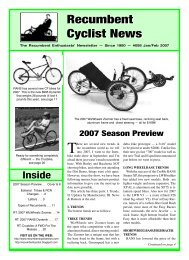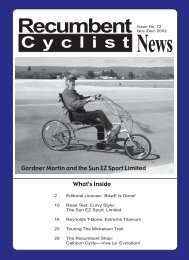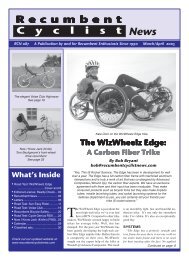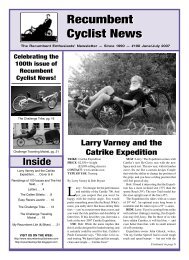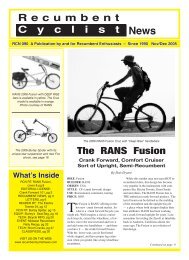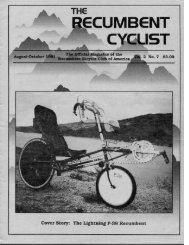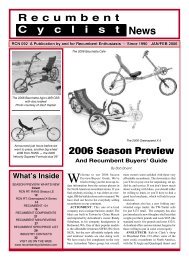Recumbent News
Recumbent News
Recumbent News
You also want an ePaper? Increase the reach of your titles
YUMPU automatically turns print PDFs into web optimized ePapers that Google loves.
Note Penninger jackshaft and two rear derailleurs<br />
accustomed to the steering-arm control,<br />
but I would recommend that new riders<br />
take a few minutes of maneuvering<br />
through an open area to get the feel of it<br />
before trying it in a tight or congested area.<br />
The highly responsive steering, however,<br />
is something of a double-edged<br />
sword. While a bicycle tends to feel more<br />
stable the faster you go, and the gyroscopic<br />
action of the front wheel tends to resist<br />
any radical steering moves at higher<br />
speeds, the steering of the Voyager will<br />
respond to the steering arms quite readily<br />
even at higher speeds. A small amount of<br />
pressure on the steering arms can result in<br />
a turn, and this lends a certain twitchy feel<br />
to the steering. While riding the Voyager<br />
at speeds between 15 and 20 mph, I wondered<br />
if anyone had considered adding<br />
caster action to the front wheel, similar to<br />
how they adjust the front-end alignment<br />
of cars. By making the hub of the front<br />
wheel slightly trail the pivot point of the<br />
steering, the steering will tend to naturally<br />
track a straight line. Perhaps the design<br />
engineers have a reason for not doing this<br />
on the trikes, but it did occur to me as I<br />
was riding. That said, though, I must also<br />
comment that I had no problem whatsoever<br />
keeping the Voyager on track and in<br />
my lane, even at speeds up to 25 mph.<br />
Momentarily releasing both steering arms<br />
at any speed, though, resulted in drift very<br />
quickly. Likewise, since only the left rear<br />
wheel is driven, there is a slight tendency<br />
for the trike to want to steer to the right<br />
under heavy pedaling. This is not sufficiently<br />
evident to create a problem, and<br />
it’s only noticeable when the hold on the<br />
controls is too relaxed, but it bears remembering<br />
that the physics of the trike requires<br />
consistent attention to the steering. Heavy<br />
braking on only one or the other of the<br />
rear wheels will also cause the trike to tend<br />
10 <strong>Recumbent</strong> Cyclist <strong>News</strong> 71<br />
to pull to one side, but again, this effect is<br />
minimized by the length of the trike and<br />
the leverage the steering maintains accordingly.<br />
In the unlikely event that one brake<br />
fails, the trike would still be able to be<br />
safely stopped using the other brake, albeit<br />
in a bit longer distance. A note here<br />
on the braking: the Voyager comes with<br />
stock Shimano brake pads, which do not<br />
offer the best braking power. Frank at Ajo<br />
Bikes swapped these out for better brake<br />
pads after my initial spin on the trike<br />
(which he normally does before selling the<br />
trike). The beefier brake pads gave a much<br />
more satisfying feel of braking power over<br />
the stock pads, and I immediately understood<br />
why Frank routinely replaces them.<br />
Another surprising factor on the Voyager<br />
is that at no time during the test ride<br />
did it ever feel as though I was pedaling a<br />
50-pound vehicle. Despite its weight, the<br />
Voyager rolls smoothly and accelerates<br />
well. The twin 8-speed cassettes, augmented<br />
by a double chainring up front (a<br />
52/39 combo), offers the amazing total of<br />
128 different gear combinations.<br />
Penninger advertises that the gear-inches<br />
on the Voyager range from 16 to 85. To<br />
check how well the Voyager starts up<br />
against a hill, I stopped at the bottom of a<br />
short but somewhat steep underpass. In<br />
the lowest gear combination of the twin<br />
cassettes, but still in the 52-tooth<br />
chainring, I started climbing almost effortlessly.<br />
It took me a moment, though, to<br />
realize that I was actually slightly lifting<br />
the front wheel with the torque I was applying<br />
through the low gearing. Please<br />
note on this that I had the seat positioned<br />
all the way back, placing it almost directly<br />
over the rear axle and distributing my<br />
weight predominantly back. Once I noticed<br />
the wheelie effect, I backed off on<br />
my pedaling effort slightly to maintain<br />
Voyager drivetrain<br />
The Voyager<br />
Voyager in Toyota pickup<br />
contact with the front tire. The chainrings<br />
do not have a derailleur, though, and must<br />
be shifted by hand. With practice I’m sure<br />
a person could do this while riding, but<br />
my attempt to do so merely resulted in a<br />
jumped chain.<br />
While it might have been this trike’s<br />
novelty to a certain extent, I have to say<br />
that the Voyager was fun to ride. The learning<br />
curve was fairly short, and I would<br />
venture that nearly anyone would be able<br />
to get on one and go out and enjoy it<br />
quickly. My 18-year-old son took it for a<br />
test spin and wondered how long it would<br />
take him to be able to afford one.<br />
Owning<br />
The Voyager seems well suited for tour-



